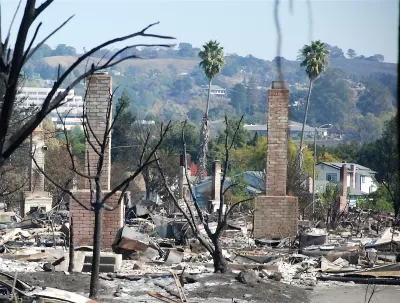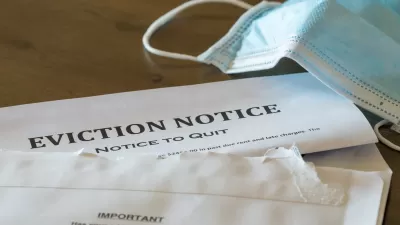Low-income renters face an increased risk of eviction after a natural disaster. Most cities and states don’t offer any protection.

A Sonoma County, California ordinance passed last month bars landlords from evicting tenants during weather disasters and other declared emergencies. The first-in-the-nation “disaster-triggered” moratorium aims to prevent waves of evictions similar to those that impacted residents in Florida during the 2021 hurricane season. The Sonoma ordinance is the result of activism from the region’s large agricultural worker community, who suffered after 2017’s Tubbs Fire.
In a Bloomberg CityLab article, Patrick Sisson explains how natural disasters lead to evictions. “Lack of internet access can cut off the ability to pay rent online, and those who evacuated can’t just drop off rent checks. Jobs are upended and schools close, putting childcare strains on working parents. And damage to homes and workplaces continue to exact a lingering economic toll on the afflicted area long after emergency response is completed.” Compounding the problem, a study found that rents go up by 4 percent to 6 percent in impacted areas, and evictions rise sharply.
Supporters of the Sonoma law hope it can be a model for other communities, particularly in vulnerable areas like south Texas and Florida.
FULL STORY: Should Evictions Be Banned After Hurricanes and Climate Disasters?

Study: Maui’s Plan to Convert Vacation Rentals to Long-Term Housing Could Cause Nearly $1 Billion Economic Loss
The plan would reduce visitor accommodation by 25,% resulting in 1,900 jobs lost.

Placekeeping: Setting a New Precedent for City Planners
How a preservation-based approach to redevelopment and urban design can prevent displacement and honor legacy communities.

Using Old Oil and Gas Wells for Green Energy Storage
Penn State researchers have found that repurposing abandoned oil and gas wells for geothermal-assisted compressed-air energy storage can boost efficiency, reduce environmental risks, and support clean energy and job transitions.

Washington State Plans Ambitious ‘Cycle Highway’ Network
The state is directing funding to close gaps in its existing bike network and make long-distance trips more accessible.

Homeowners Blame PG&E for Delays in ADU Permits
The utility says it has dramatically reduced its backlog, but applicants say they still face months-long delays for approvals for new electrical work.

Rethinking Wildfire Defense: How a Landscape Approach Can Protect Neighborhoods
Post-fire analysis of the Eaton Fire reveals that a landscape approach — including fire-resistant vegetation, home hardening, and strategic planning — can help reduce wildfire risk, challenging assumptions that trees and plants are primary fire hazards.
Urban Design for Planners 1: Software Tools
This six-course series explores essential urban design concepts using open source software and equips planners with the tools they need to participate fully in the urban design process.
Planning for Universal Design
Learn the tools for implementing Universal Design in planning regulations.
Borough of Carlisle
Caltrans
Heyer Gruel & Associates PA
Institute for Housing and Urban Development Studies (IHS)
City of Grandview
Harvard GSD Executive Education
Salt Lake City
NYU Wagner Graduate School of Public Service
City of Cambridge, Maryland





























